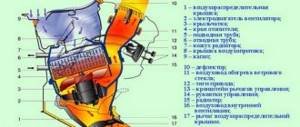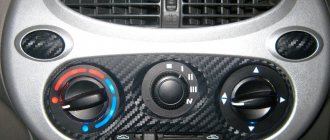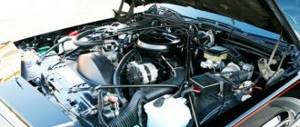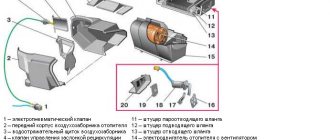The heater of the Lada Granta car is installed under the instrument panel in the center.
The heater fan housing is located behind the glove compartment on the right.
An air duct is installed between the heater and the fan.
Engine coolant circulates through the heater core.
The air flow is regulated by a damper, which is connected to the temperature controller.
The fan housing contains the fan, an additional resistor and a recirculation damper.
The fan motor speed can rotate at four different speeds depending on the connection of an additional resistor.
An additional resistor is connected via a fuse.
Elements of the heating, air conditioning and ventilation system located in the interior of the LADA Granta
Rice. 1 (view with the instrument panel removed): 1 — left air duct: 2 — air supply duct to the central vents of the instrument panel; 3 — instrument panel frame; 4 — right air duct; 5 — recirculation block; b — air blower; 7 — fan electric motor; 8 — block of additional resistors; 9 - air duct (included with the air conditioner - installation location of the evaporator housing); 10 — heater block housing
The car is equipped with a liquid-type heater. Main heater components:
If the stove blows cold
In this situation, several options are possible. Air lock - antifreeze does not flow into the heater radiator. You need to touch the radiator, this can be done from the passenger seat. Just be careful, if the radiator is leaking, you can get burned.
The radiator is located under the center console to the left of the front passenger. In the gallery above there is an arrow with the location of both the radiator and the heater valve.
The Lada Granta passenger car, which is considered one of the most affordable in the world, is equipped with a “stove” (or simply a heater) that is standard for VAZ cars. Typically this unit works very well, but problems can still occur. Therefore, if the Lada Granta stove does not heat well, then there must be reasons for this that simply need to be discovered.
Block of additional resistors LADA Granta
The block of additional resistors 8 (see Fig. 1) consists of three resistors and a fuse. When current passes:
- through all three resistors, the 1st rotation speed of the heater fan is ensured,
- through two resistors - 2nd speed,
- after one -3rd speed.
- when the electric motor is turned on without an additional resistor, the armature of the fan motor rotates at the maximum 4th speed;
Method No. 2: replacing the Lada Granta heater radiator without removing the panel
- Unscrew the expansion tank cap and release the pressure in the system.
Expansion tank plug
- We unscrew the plug in the cylinder block and grind the antifreeze into a plastic container.
- We disconnect the block with wires from the pedal unit: brake, accelerator, clutch.
- In the engine compartment, turn off the mass air flow sensor.
Mass air flow sensor
- We saw off the upper and lower pipes of the heat exchanger.
- We recess the pedal module and remove the heater from its original place.
- We clean the seat and blow out the cavity.
- We install the new radiator in its original place.
- We install pipes - connectors.
- Fill in 8.0 liters of pure antifreeze. We start the engine and check the system for leaks.
The process of replacing the radiator of a Lada Granta stove with air conditioning is similar to that described above.
Is it better to do it yourself or contact a service station?
Considering the simplicity of the process, replace the radiator yourself. If necessary, additionally read the recommendations outlined in the article, watch video tutorials, and get advice from specialists.
Undocumented capabilities of the Lada Granta heater
Unlike a number of other foreign cars, the Lada Grant has only four heater control switching modes. For example, there are six of them in Audi and Opel.
The air supply lines are connected in such a way that the windshield is heated at any position of the regulator. There is no such option in domestic transport.
In winter, when the air conditioning is activated, most of the air is automatically directed to the feet, in summer to the windshield for blowing. In Grant the flow is of the same type.
LADA Granta heater radiator (heat exchanger)
The heater heat exchanger is designed to heat the air entering the cabin with the heat of the engine coolant. The heater radiator is connected to the engine cooling system by two hoses running in the engine compartment.
The heater radiator is placed and a plastic housing 10 (see Fig. 1) is installed in the central part of the instrument panel.
Cooling
To cool the interior air, do the following:
- Switch switch 1 (see Fig. 2) of the electric fan operating modes to one of the positions “1”, “2”, “3” or “4”.
- Place the regulator handle 4 opposite the pictogram.
- In the 3 pushbutton switch block, press the air conditioner switch key. The indicator located on the switch button will light green all the time the air conditioner is operating.
When the air passing through the evaporator cools, the water vapor contained in it condenses. The condensate is drained through a drain pipe under the bottom of the car. If the ambient air humidity is high, a puddle of water may form under the car, which is an indirect sign that the air conditioning system is working properly.
Turning on the air conditioner while the engine is running under difficult conditions (long climbs, heavy city traffic, etc.) can lead to engine overheating. Monitor the coolant temperature gauge: if the temperature exceeds the permissible value, turn off the air conditioner. During long trips in city traffic, the efficiency of the air conditioner may decrease due to the intense thermal conditions of the engine. This is not a sign of malfunction; the air conditioner will operate effectively when driving under normal road conditions.
- climate block grants
- air duct grants
- air conditioning grants
- stove grants
Lada Granta is one of the most popular cars in Russia in 2020, along with KIA Rio, VW Polo, Lada Vesta, Hyundai Solaris and Hyundai Creta. This popularity of the car is explained, first of all, by the optimal combination of price and quality: Granta owners note good visibility, an acceptable power unit, ease of maintenance, low cost of spare parts, a spacious trunk, high ground clearance, which is extremely important for Russian realities. Among the components that are indispensable in the cold season is a heater, the main component of which is the radiator. If a situation arises when it is necessary to replace the stove radiator, then in most cases this can be done without outside help. What should the owner of a Lada Granta remember who has decided to replace the heater radiator on his own?
Interior temperature sensor for LADA Granta
The interior temperature sensor is located in the interior lighting housing. To eliminate incorrect temperature readings due to the influence of heated elements, the sensor is equipped with a forced airflow system. The system ensures uniform flow of air from the front of the vehicle through the sensor housing.
To ensure proper air movement, keep the inlet of the sensor housing free from any solid particles or liquids. This is especially true in cases of dry cleaning of the interior. When cleaning the interior with a vacuum cleaner, it is strictly forbidden to bring the suction tip of the vacuum cleaner pipe to the sensor inlet. If air flow through the sensor housing is obstructed, the normal functioning of the automatic climate control system is disrupted.
Sequence of actions when replacing the Lada Granta heater radiator
Note to the driver!
There are two ways to dismantle the heater radiator on a Lada Grant: according to the instruction manual and the “folk method”. Let's look at each with a specific example.
- We place the car within the perimeter of the repair area, turn off the engine, and open the hood. We provide priority safety measures.
- After the engine has cooled down, we proceed to dismantling the heating system on the Lada Grant without a condenser.
Some good advice
To avoid problems with your heating system, it must be carefully monitored. For example, after purchasing a new car, observe the condition of the cooling system hoses in the engine compartment. Also, check under the car regularly to see if there are any black spots underneath. If you notice traces of antifreeze, quickly seek professional help or fix the problem yourself.
Please note that after completing the repair work, it is advisable to replace the radiator hoses with new ones. In this case, use sealant at the joints. You should be extremely careful, because sealant that gets inside the system can damage the pump, which will lead to the timing belt breaking.
Adviсe
Antifreeze leaked into the cabin
To prevent problems with the heater core, you need to carefully monitor it. For example, from the first days of buying a car, periodically look under the car to see if there are dark spots there. And in the engine compartment it would be a good idea to observe the condition of the cooling system hoses. If you notice traces of antifreeze in any of these places, you need to immediately seek help, or carry out repairs yourself.
If possible, the hoses for connecting the heater radiator should be replaced with new ones, having coated the connection points with sealant. But some do not agree with this opinion. After all, sealant from the hose can get inside the cooling system and cause damage to the pump. As a result, the timing belt will break and the valves will meet the pistons.
We dismantle the radiator of the Lada Granta stove
This radiator eventually leaked into the car interior. And antifreeze vapors are harmful!
Despite the fact that there are usually no complaints about the quality of the stove, breakdowns can still occur. If you focus on the radiator, it may clog or leak. In any case, you need to immediately begin dismantling the stove, after which it will be possible to inspect it in detail and understand the causes of the breakdown.










